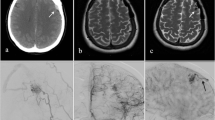Abstract
Purpose
Dural arteriovenous fistulae (dAVF) are an uncommon feature of PTEN hamartoma tumor syndrome (PHTS). We report a case of an adolescent male diagnosed with PHTS following the treatment of multiple intracranial dAVF to emphasize the association of vascular anomalies with this disorder and discuss potential implications.
Case Report
An adolescent male presented with bilateral proptosis secondary to intracranial venous hypertension. Workup revealed the presence of a complex intracranial dAVF which was treated with several embolization procedures. Following treatment, a de novo dAVF was identified on surveillance imaging. A genetic workup revealed a pathogenic mutation in PTEN consistent with a diagnosis of PHTS.
Conclusions
Recognition that PHTS may be associated with dAVF, and potentially delayed spontaneous formation of dAVF, is critically important due to the potential for devastating yet preventable neurologic sequelae.




Similar content being viewed by others
References
Cognard C et al (1995) Cerebral dural arteriovenous fistulas: clinical and angiographic correlation with a revised classification of venous drainage. Radiology 194:671–680
Online Mendelian Inheritance in Man OMIM® (2020) Johns Hopkins University, Baltimore, MD. MIM Number: 601728: 08/28/2020. World Wide Web URL: https://omim.org/
Marsh DJ et al (1999) PTEN mutation spectrum and genotype-phenotype correlations in Bannayan-Riley-Ruvalcaba syndrome suggest a single entity with Cowden syndrome. Hum Mol Genet 8:1461–1472
Mester J, Eng C (2012) Estimate of de novo mutation frequency in probands with PTEN hamartoma tumor syndrome. Genet Med 14:819–822
Lachlan KL, Lucassen AM, Bunyan D, Temple IK (2007) Cowden syndrome and Bannayan Riley Ruvalcaba syndrome represent one condition with variable expression and age-related penetrance: results of a clinical study of PTEN mutation carriers. J Med Genet 44:579–585
Pilarski R, Eng C (2004) Will the real Cowden syndrome please stand up (again)? Expanding mutational and clinical spectra of the PTEN hamartoma tumour syndrome. J Med Genet 41:323–326
Ekinci S, Karnak I, Balci S, Tanyel FC, Büyükpamukçu N (2006) Bannayan-riley-ruvalcaba syndrome from the point of view of the pediatric surgeon. Eur J Pediatr Surg 16:209–213
Erkek E et al (2005) Clinical and histopathological findings in Bannayan-Riley-Ruvalcaba syndrome. J Am Acad Dermatol 53:639–643
Tan MH et al (2012) Lifetime cancer risks in individuals with germline PTEN mutations. Clin Cancer Res 18:400–407
Hendricks LAJ, Hoogerbrugge N, Schuurs-Hoeijmakers JHM, Vos JRA (2020) A review on age-related cancer risks in PTEN Hamartoma Tumor Syndrome. Clin Genet
Sansal I, Sellers WR (2004) The biology and clinical relevance of the PTEN tumor suppressor pathway. J Clin Oncol 22:2954–2963
Hamada K et al (2005) The PTEN/PI3K pathway governs normal vascular development and tumor angiogenesis. Genes Dev 19:2054–2065
Dong X et al (2013) Inhibition of PTEN expression and activity by angiotensin II induces proliferation and migration of vascular smooth muscle cells. J Cell Biochem 114:174–182
Lok C et al (2005) Brain magnetic resonance imaging in patients with Cowden syndrome. Medicine 84:129–136
Plamper M et al (2020) Cerebral MRI and clinical findings in children with PTEN hamartoma tumor syndrome: can cerebral MRI scan help to establish an earlier diagnosis of PHTS in children? Cells 9:1668
Sadahiro H et al (2014) Postoperative dural arteriovenous fistula in a patient with Cowden disease: a case report. J Stroke Cerebrovasc Dis 23:572–575
Prats-Sánchez LA et al (2016) Multiple intracranial arteriovenous fistulas in Cowden syndrome. J Stroke Cerebrovasc Dis 25:e93–e94
Dhamija R et al (2018) Neuroimaging abnormalities in patients with Cowden syndrome: retrospective single-center study. Neurol Clin Pract 8:207–213
Tan WH et al (2007) The spectrum of vascular anomalies in patients with PTEN mutations: implications for diagnosis and management. J Med Genet 44:594–602
Moon K et al (2013) Complex dural arteriovenous fistula in Bannayan-Riley-Ruvalcaba syndrome. J Neurosurg Pediatr 12:87–92
Palencia R, Ardura J (1986) Bannayan syndrome with intracranial arteriovenous malformations. An Esp Pediatr 25:462–466
Srinivasa RN, Burrows PE (2006) Dural arteriovenous malformation in a child with Bannayan-Riley-Ruvalcaba Syndrome. AJNR Am J Neuroradiol 27:1927–1929
Tischkowitz M et al (2020) Cancer Surveillance Guideline for individuals with PTEN hamartoma tumour syndrome. Eur J Hum Genet 28:1387–1393
Schultz KAP et al (2017) PTEN, DICER1, FH, and their associated tumor susceptibility syndromes: clinical features, genetics, and surveillance recommendations in childhood. Clin Cancer Res 23:e76–e82
Lin YH et al (2018) Diagnostic accuracy of CTA and MRI/MRA in the evaluation of the cortical venous reflux in the intracranial dural arteriovenous fistula DAVF. Neuroradiology 60:7–15
Mossa-Basha M, Chen J, Gandhi D (2012) Imaging of cerebral arteriovenous malformations and dural arteriovenous fistulas. Neurosurg Clin N Am 23:27–42
Acknowledgements
We thank Sumit Pruthi, MBBS and Daniel J. Benedetti, MD, MA, for their insight into this topic and contributions in the drafting of this manuscript.
Author information
Authors and Affiliations
Contributions
Conceptualization: Michael Froehler, MD, Ph.D.; methodology: Steven Roth, MD; formal analysis and investigation: Steven Roth, MD; writing — original draft preparation: Steven Roth, MD; writing — review and editing: Steven Roth, MD; Michael Feldman, MD; Alexandra Borst, MD; Michael Froehler, MD, Ph.D.; supervision: Michael Froehler, MD, Ph.D.
Corresponding author
Ethics declarations
Ethics approval
This work was approved by the Vanderbilt University Medical Center Institutional Review Board (IRB #210237).
Consent to participate
Informed consent obtained from subject and family members. Consent form included with submission
Consent for publication
Informed consent obtained from subject and family members. Consent form included with submission
Conflict of interest
The authors declare no competing interests.
Additional information
Publisher's Note
Springer Nature remains neutral with regard to jurisdictional claims in published maps and institutional affiliations.
Rights and permissions
About this article
Cite this article
Roth, S.G., Feldman, M.J., Borst, A.J. et al. Formation of a de novo intracranial arteriovenous fistula in a child with PTEN hamartoma tumor syndrome. Childs Nerv Syst 38, 1029–1033 (2022). https://doi.org/10.1007/s00381-021-05321-6
Received:
Accepted:
Published:
Issue Date:
DOI: https://doi.org/10.1007/s00381-021-05321-6




